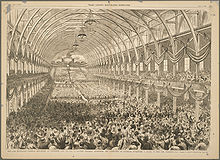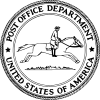Marshall Jewell
Marshall Jewell | |
|---|---|
Governor of Connecticut | |
| In office May 16, 1871 – May 7, 1873 | |
| Lieutenant | Morris Tyler |
| Preceded by | James E. English |
| Succeeded by | Charles Ingersoll |
| In office May 5, 1869 – May 4, 1870 | |
| Lieutenant | Francis Wayland III |
| Preceded by | James E. English |
| Succeeded by | James E. English |
| Personal details | |
| Born | October 20, 1825 Winchester, New Hampshire, U.S. |
| Died | February 10, 1883 (aged 57) New Haven, Connecticut, U.S. |
| Political party | Whig (Before 1854) Republican (1854–1883) |
| Signature | |
Marshall Jewell (October 20, 1825 – February 10, 1883) was a manufacturer, pioneer
A native of New Hampshire, Jewell was the son of a prominent tanner and currier. Having apprenticed in his father's tannery business,[2] Jewell moved to Boston where he learned the art of being a currier. In 1847, Jewell moved to Hartford where he worked for his father's business as a currier. Jewell stopped working as a currier and became a skilled telegrapher, where he worked in New York, Ohio, and Tennessee. Jewell was a Whig who supported the election of Zachary Taylor to the office of the presidency. Having supported Taylor, Jewell moved to Mississippi where he was elected General Superintendent of Telegraphers.[2] Jewell moved back to New York in 1849, and in 1850 he returned to his father's tannery business having entered into partnership with his father. Between 1859 and 1860, Jewell traveled to and visited Europe on business connected with the tannery firm, having returned to the United States during the onset of the American Civil War. In 1865 Jewell returned to Europe and traveled to Egypt and the Holy Land.[2]
Having returned to the United States, Jewell, a
Early life and career
Marshall Jewell was born in Winchester, New Hampshire on October 25, 1825.[1] His father, Pliny Jewell, native of Hartford, was a prominent tanner and currier. His mother was Emily Alexander. His elder brother was named Harvey Jewell. The young Marshall received a limited education at common schools.[5] At an early age Jewell apprenticed for his father in the tannery business working as a day laborer until the age of 18. Jewell moved to Woburn where he learned the skill of being a currier.[5] Jewell returned to his father's tannery business in Hartford where he worked in the currier shop for two years.[1] In 1847, Jewell grew tired of the tannery business and having good business sense learned the telegraphy trade working in Boston, Rochester, and Akron.[5] As a highly skilled telegrapher, Jewell was put in charge of the Louisville and New Orleans telegraph line working in Columbia, Tennessee.[1][5]
Early political involvement

In 1848, while working as a telegrapher, Jewell became interested in national politics becoming a Whig. Jewell supported Zachary Taylor for President of the United States. Jewell's political opinions would later draw him into the Republican Party formed in the mid-1850s[5] In 1849, Jewell returned north and was elected Superintendent of the telegraph line between Boston and New York living in New York City.[1][5]
Tanning partnership established
While Jewell was working as a telegrapher, Jewell's father Pliny's tanning business had increased substantially. Having left the telegraph business, moving back to Hartford, Jewell entered into partnership with his father's tanning and belting business on January 1, 1850.[1][5] Jewell, who had good business sense, for the next eight years increased his father's business and gained a positive reputation in the Hartford community.[1] Between 1852 and 1857 Jewell traveled widely throughout the United States to promote his manufactured leather product business.[5]
World travels and the American Civil War
From 1859 to 1860, Marshall went on a trip to Europe in order to expand his leather business. During the onset of the American Civil War Jewell purchased leather putting his business in a good position to gain government contracts.[5] During the Civil War, Jewell's tanning business flourished having supported the Northern war effort.[3] After the Civil War ended Jewell returned to Europe and extended his travels to Egypt and the Holy Land from 1865 to 1867.[1][5]
Governor of Connecticut

Having returned from his extensive world travels abroad, in 1867, Jewell unsuccessfully ran for Connecticut state senator, having joined the Republican Party. In 1868, Jewell unsuccessfully ran for Governor of Connecticut. In 1869, Jewell was elected Governor of Connecticut having served until his defeat in 1870. Jewell was returned to office in the disputed election of 1871, and was last elected governor in 1872, having served three terms in office until 1873.[3] During Jewell's second term in office, Russian Grand Duke Alexis visited Washington, D.C., and Hartford, Connecticut. While in Hartford the Grand Duke stayed at Gov. Jewell's house. The Grand Duke was impressed by Jewell's ability to improve his status in the United States, having stated, "What! Is this the way Americans rise? from the tannery to the governor's chair?"[6]
U.S. Minister to Russia
On May 20, 1873, Ulysses S. Grant nominated Jewell as Minister to Russia, to replace
While in Russia, Jewell, as a tanner, discovered that the Russians used
U.S. Postmaster General
In 1874, a vacancy was created in President Grant's Cabinet when
Reform efforts
Jewell took up the office of U.S. Postmaster with vigor, a man of many words and theories, having desired to reform the Postal Service from profiteering in lucrative postal contracts known as Star Routes. Having studied the European postal system, Jewell was the first post-master to establish a direct postal route service from New York City to Chicago.
Resignation
Washington, D.C., proved to be a challenge for Jewell's reforms of the Postal Service. During his tenure partisan politics caused Jewell to lose President Grant's support.
Return to Hartford
After Jewell had been dismissed by President Grant as Postmaster, Jewell returned to Hartford who welcomed Jewell with open arms. Jewell devoted his time to his tanning business that had faltered while he had been away. Through a series of investments in the Hartford Evening Post and the
1876 Republican Convention

During the 1876 Republican National Convention held in Cincinnati, Ohio, Marshall Jewell was nominated by the State of Connecticut for President of the United States. Grant chose not to run and the Republicans did not choose to nominate him for a consecutive third term. Jewell was the first person from the State of Connecticut to be nominated at a national Republican Presidential Convention. On the first presidential ballot, Jewell received 11 votes, ten from Connecticut.[11] Jewell's name, however, was withdrawn from the remaining ballots. Benjamin Bristow also ran for the Republican presidential candidacy, but he could not get enough votes at the end of the balloting. Although Bristow was a frontrunner and had Jewell's support, he was considered controversial for his prosecution of the Whiskey Ring, a scandal that involved prominent Republican Party members. Instead, Rutherford B. Hayes, went on to win the Republican presidential nomination by receiving 384 votes on the seventh ballot.[12] Jewell was also nominated for Vice President of the United States by S.H. Russell from Texas; however, William A. Wheeler was unanimously nominated on the first ballot by 366 majority votes.[13] William Kellogg withdrew Jewell's name from the ballot after the votes cast were unanimously for Wheeler.[13] The state of Connecticut named Jewell on the 1876 Republican National Committee who elected Zachariah Chandler as chairman.[14]
Chairman of Republican Party
In 1879 Jewell accepted the appointment of National Chairman of the Republican Party having served to 1880. During the presidential election of 1880, Jewell's energetic approach to politics resulted in large part to the election of Republican candidate James A. Garfield to the office of President of the United States.[6]
Death, burial, and memorial

Although considered a man of vitality in 1883, Jewell had contracted pneumonia that quickly took his life. When Jewell asked his doctor "How long does it take for a man to die?" His doctor responded, "In your condition, Governor, it is a matter of only a few hours." Marshall Jewell died on February 10, 1883, in Hartford, Connecticut.[6] Jewell was buried at Cedar Hill Cemetery on Valentine's Day, February 14, 1883. Flags were held at half mast on public and private buildings. The Connecticut Legislature suspended business and adjourned for the day. The Governors Guard guarded Jewell's body held in state at the Asylum Hill Congregational Church. Thousands of people viewed Jewell's body in state and paid their respects to the former Governor. Many prominent men attended Jewell's service, including former Secretary of the Treasury Benjamin Bristow, Postmaster Timothy O. Howe, and Secretary of Navy William E. Chandler.[15] A tall column pedestal and statue memorial monument with his family's name, "JEWELL", inscribed at the base, was placed near his burial site. Jewell's wife, Esther E Dickerson Jewell, died February 26, 1883, and was buried next to her husband Marshall Jewell at Cedar Hill Cemetery.
His daughter was Josephine Jewell Dodge, a prominent early childhood educator and anti-suffrage activist.[16]
References
- ^ a b c d e f g h i j k l m n Chicago Daily Tribune (February 18, 1883), Marshall Jewell
- ^ a b c d e f New York Times (July 4, 1874), Appointment and Acceptance of the Hon. Marshall Jewell
- ^ a b c d e Miller Center (2012), Marshall Jewell (1874–1876): Postmaster General Archived May 8, 2012, at the Wayback Machine, Retrieved May 24, 2012
- ^ "The Political Graveyard: Hartford County, Conn". Cedar Hill Cemetery. Archived from the original on May 14, 2008. Retrieved April 29, 2008.
- ^ a b c d e f g h i j k l m n o Moody 1933, p. 64.
- ^ a b c Holloway (1885), Famous American Fortunes and the Men who Have Made Them, p. 446
- ^ Holloway, pp. 442-443
- ^ Holloway, p. 443
- ^ New England Historic Genealogical Society, p. 127
- ^ Appletons' Cyclopædia of American Biography 1887, p. 432.
- ^ Tweedy (1910). A history of the Republican national conventions from 1856 to 1908. pp. 155–157.
- ^ Tweedy 1910, p. 156
- ^ a b Tweedy 1910, pp. 157–158
- ^ Tweedy 1910, p. 158
- ^ New York Times (February 15, 1883), Laid at Rest.; Funeral of Ex-Gov. Marshall Jewell at Hartford.
- ISBN 9780674627345
Sources
- Moody, Robert E. (1933). Dumas Malone (ed.). Dictionary of American Biography Jewell, Marshall. New York City: Charles Scribner's Sons.
- Wilson, James Grant; Fiske, John, eds. (1887). Appletons' Cyclopædia of American Biography Jewell, Marshall. New York City: D. Appleton and Company. pp. 431–432.



